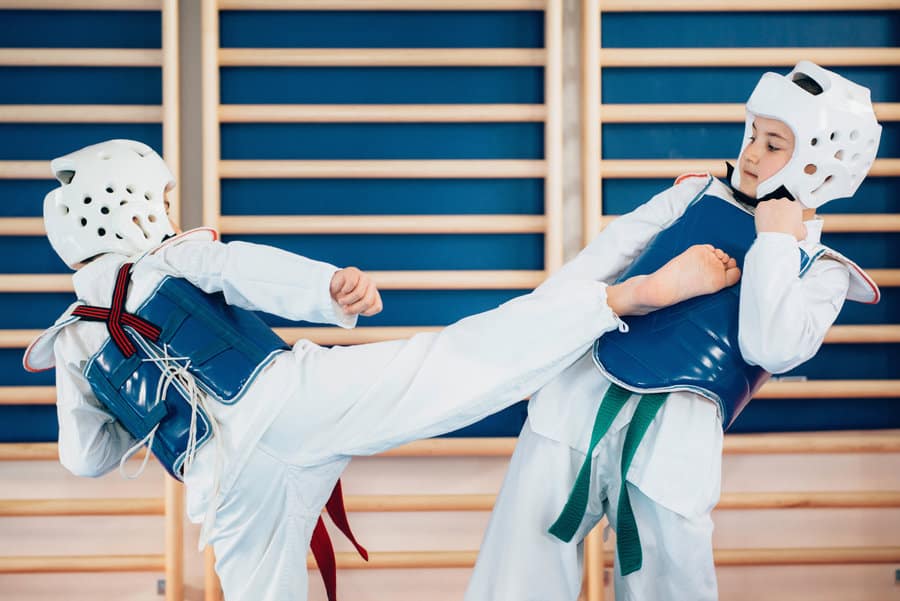
One-step sparring in Taekwondo is a controlled drill where you practice self-defense moves against a single attack. As a beginner a few years into Taekwondo, I wondered about its purpose—why practice these choreograOne-Step Sparring in Taekwondo: A Complete Beginner’s Guide
One-step sparring in Taekwondo is a controlled drill where you practice self-defense moves against a single attack. As a beginner a few years into Taekwondo, I wondered about its purpose—why practice these choreographed steps?
It’s a powerful tool to build technique, timing, and confidence for real-life situations. This guide breaks down its history, how to perform it, why it matters, and tips to master it, whether you’re new to the dojang or prepping for a belt test.
What Is One-Step Sparring?
One-step sparring is a Taekwondo drill where you counter a single attack with a practiced move. It’s a beginner-friendly way to build self-defense skills in a controlled setting. Known as “Ilbo Matsogi” in Korean (or “Hanbon Kyorugi” in some WT schools), it involves a choreographed sequence.
You respond to a partner’s pre-set attack—like a punch or kick—with a specific block and counter, such as an outer forearm block followed by a reverse punch. The focus is on clean form and quick reaction, making it a safe way to learn before tackling live sparring. It’s like a stepping stone, preparing you for real-world scenarios without the intensity of a full fight.
History of One Step Sparring in Taekwondo

One-step sparring, born in the 1930s from karate’s Gigo Funakoshi and shaped by Taekwondo’s General Choi, mimics real fights. Its kendo-inspired roots make it a timeless training tool. Gigo, son of Shotokan founder Gichin Funakoshi, developed it around 1935–1939, drawing from kendo’s long-distance fencing drills. He had students stand one step apart, practicing choreographed counters to simulate combat.
In the 1950s, General Choi Hong-hi, a Taekwondo pioneer, adapted it for the ITF, emphasizing high kicks and self-defense. By the 1960s, as Taekwondo spread to Europe, Latin America, and beyond, one-step sparring became a global standard, with schools tailoring combinations to their curriculum. Its focus on precision and realism keeps it relevant today.
How Is One-Step Sparring Performed?
Performing one-step sparring involves precise, choreographed steps to counter attacks. You’ll bow, block, and strike in a drill that hones technique and prepares you for real scenarios. Here’s the process:
- Stand one foot from your partner, bow, and take a ready stance (e.g., parallel stance).
- The instructor shouts “shijak” (start) or “junbi” (ready).
- Both yell “Kihap” to signal focus and readiness.
- Your partner throws a pre-set attack, like a straight punch or front kick.
- You block (e.g., outer forearm block) and counter (e.g., reverse punch), stopping short of contact.
- Bow and repeat for each technique in the set, often 5–10 moves.
Each school has its own list, but the goal is always sharp, controlled execution, building muscle memory for self-defense.
Purpose of One-Step Sparring in Taekwondo
One-step sparring teaches Taekwondo students to react with confidence in self-defense situations. It builds core skills like timing and distance, rooted in the art’s disciplined philosophy. Designed for all levels, it’s especially helpful for beginners mastering basic blocks and strikes. It simulates real-life scenarios—think blocking a punch in a tense moment—letting you practice under pressure. It’s a key part of belt tests, showing instructors your skill and poise. Beyond technique, it fosters:
- Timing: Know when to block or strike for impact.
- Distance: Stay in range to land or dodge attacks.
- Muscle Memory: Make moves automatic through repetition.
- Confidence: Gain assurance in a safe, controlled drill.
Tied to Taekwondo’s “do” (way), it emphasizes focus and respect, preparing you mentally and physically for real-world challenges.
Benefits for Different Skill Levels

One-step sparring grows with you, from beginner blocks to advanced counters. It offers tailored benefits, helping every Taekwondo student sharpen skills at their own pace. For beginners, it’s a gentle start, teaching simple blocks (e.g., low block) and strikes (e.g., front kick) without the stress of live sparring. Intermediate students tackle complex combos, like a double block and roundhouse kick, refining timing and flow.
Advanced belts face non-pre-arranged or recounter drills, reacting to random attacks with speed and creativity, mimicking real fights. This flexibility ensures one-step sparring remains a valuable tool, building confidence and competence whether you’re a white belt or black belt.
One-Step Sparring vs. Free-Form Sparring
One-step sparring and free-form sparring differ in structure and goals. While one-step drills focus on set moves, free sparring tests adaptability, making them perfect training partners. Free-form sparring, like point or full-contact, involves random techniques traded for a set time, testing speed and strategy.
One-step sparring is choreographed, like a kata, with pre-set moves and limited contact—you block but don’t strike beyond the block. Free sparring builds agility and endurance; one-step hones precision and control. Together, they create a balanced Taekwondo fighter, ready for both planned and unpredictable scenarios.
One-Step Sparring in Belt Testing
Belt tests often include one-step sparring to gauge your technique. You’ll perform specific counters, showing off your Taekwondo skills to earn that next rank. Common tasks include:
- 5 counters off a straight punch (e.g., inner forearm block, front snap kick).
- 5 counters off a side kick (e.g., low block, roundhouse kick).
- 5 counters off a front kick (e.g., downward block, elbow strike).
- 5 counters off a takedown (e.g., wrist escape, palm heel strike).
White belts use basic moves, like a single block and punch, while higher ranks perform tougher combos, like a block, dodge, and spinning crescent kick. Passing requires accuracy, confidence, and meeting other test criteria, like Poomsae or live sparring.
One-Step Sparring by Taekwondo Organization

Taekwondo organizations like ATA, ITF, and WT set distinct one-step sparring rules. Each tailors drills to fit their focus, from self-defense to sport competition. The ATA guides beginners through 1/2/3-step sparring, progressing to free sparring with set combos (ATA Martial Arts).
ITF schools use similar lists, emphasizing kick-heavy self-defense for each belt. WT prioritizes sport sparring, but some dojang, like mine, include one-step for self-defense training. Many schools craft custom lists, ensuring students master techniques suited to their curriculum and goals.
Evolution of One-Step Sparring
One-step sparring evolves from simple counters to complex drills as you advance. Higher belts face tougher challenges, pushing your Taekwondo skills to new levels. It includes:
- Traditional: Counter one attack, often on both sides (e.g., left/right punch).
- Two-Step: Block two attacks (e.g., punch, kick) before countering.
- Three-Step: Block three attacks before countering.
- Non-Pre-Arranged: Counter any attack, testing reflexes.
- Counter and Recounter: Counter, defend a counter, and recounter, for black belts.
These variations build adaptability, preparing you for dynamic, real-world scenarios while keeping drills structured and safe.
One-Step Sparring in Other Martial Arts
One-step sparring isn’t just for Taekwondo—BJJ, judo, and karate use similar drills. These exercises test technique under pressure, bridging martial arts traditions. In BJJ belt tests, you might:
- Show 3 closed-guard submissions (e.g., armbar, triangle choke).
- Perform 3 guard sweeps (e.g., scissor sweep, hip bump).
- Execute 3 guard passes (e.g., knee cut, toreando).
- Demonstrate 3 takedowns (e.g., single-leg, double-leg).
Judo tests scenario-based throws or counters, like responding to a grab with an ippon seoi nage. These drills, like one-step, focus on precision and control, making them universal in martial arts training.
Common Mistakes to Avoid
Beginners often stumble in one-step sparring. Avoid these pitfalls:
- Rushing Moves: Hurrying sacrifices form—slow down for clean execution.
- Wrong Distance: Standing too close or far disrupts range. Keep one foot apart.
- Weak Kihap: A quiet Kihap shows low focus. Shout loudly to stay sharp.
- Forgetting Patterns: Mixing up combos in tests looks unprepared. Memorize lists cold.
Correct these by drilling slowly with a partner and checking your stance in a mirror.
Tips for Practicing One-Step Sparring
Master one-step sparring with these practical drills:
- Break It Down: Practice blocks, steps, and counters separately, then combine for smooth flow.
- Footwork Drills: Use cones or tape to mark steps, ensuring precise movement.
- Shadow Boxing: Run combos in a mirror to catch errors, like a sloppy block.
- Partner Practice: Simulate attacks with a friend, adjusting speed to build reflexes.
- Visualization: Mentally rehearse patterns nightly to lock in memory.
- Test Prep: Record yourself running your school’s list, reviewing for form and speed.
Practice daily, starting slow and increasing pace as you gain confidence, especially before belt tests.
Final Thoughts
One-step sparring is a cornerstone of Taekwondo, sharpening your technique, timing, and confidence for self-defense. It’s as critical as Poomsae or free sparring, embodying the discipline of the “do.” In 2024, dojang blend it with real-world drills, like defending grabs or pushes, and platforms like Taekwondo Wiki offer video tutorials for home practice. Try it in your dojang, drill with a partner, or watch ITF clips online to see masters at work. It’ll make you a sharper, more prepared martial artist. Keep training hard!
FAQ: One-Step Sparring in Taekwondo
What is one-step sparring?
A choreographed Taekwondo drill where a student counters a partner’s attack with a pre-set self-defense move.
How is one-step sparring used in belt tests?
Students perform set counters (e.g., block and strike) to show technique and memory, with complexity rising by belt rank.
How does it differ from free sparring?
One-step uses pre-set moves with limited contact; free sparring is random and full-contact.

